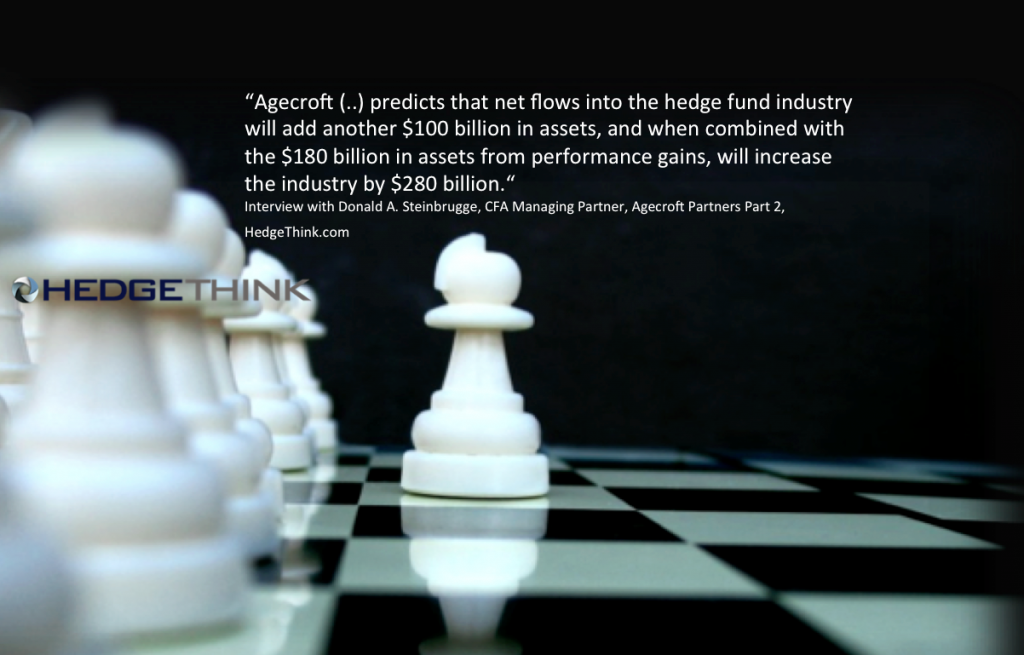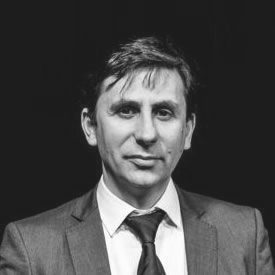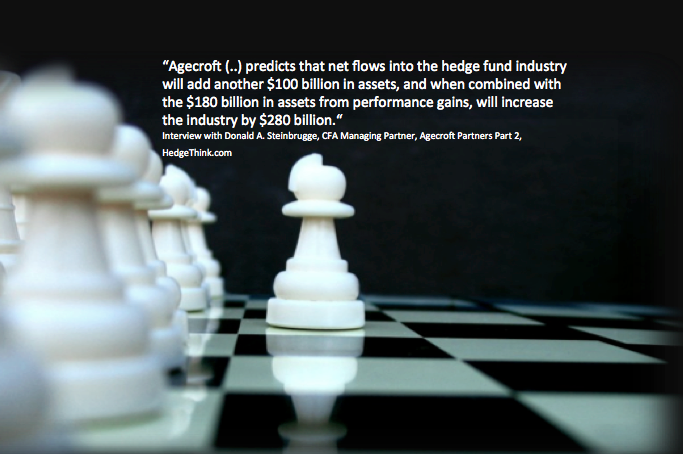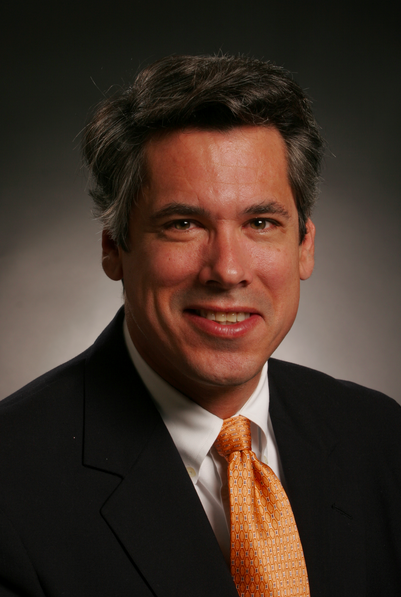
HedgeThink proudly presents the 2nd part of an epic interview with Donald A. Steinbrugge, CFA Managing Partner, Agecroft Partners. In this second part Mr. Steinbrugge elaborates on his view about the industry, namely the challenges for hedge funds startups, the predictions his company did about the industry growth and how alternative investors can manage sell offs and related strategies. This is an interview not to miss and some great insights from one of the leading personalities in the hedge fund, alternative investment industry.
D. Guarda: What advice do you give to startup hedge funds to Raise Assets Internationally?
D. Steinbrugge: If it is a US based manager that wants to market out side of the US it is important they are properly registered for the countries they are targeting and they should be prepared to make several trips to the area. The top non-US countries to focus on are Switzerland, Canada and the UK.
D. Guarda: What hedge fund strategy protects investors during a market selloff?
D. Steinbrugge: There are a lot of investors that are concerned with the increase in volatility in the market place along with the recent market sell off. The strategies listed below have low correlation to the stock and bond markets and should do well verse most other strategies if these current market trends continue.
- Private Lending – Credit spreads on private lending have not tightened similarly to other credit securities due to the difficulty in mid-sized companies getting financing from traditional lenders.
- Market Neutral Equity – Net exposure is typically between plus or minus 10%. Objective is to add value through stock selection and not timing the market.
- Reinsurance – Funds that are broadly diversified across property risk (earth quake, fire, hurricane) have very low correlation to the equity markets.
- Credit Arbitrage/ Relative Value Fixed Income– This is a broad category that covers managers that hedge a large percent of their duration and credit exposure and generate returns through security selection and potentially active trading in less liquid markets. The key here is fully understanding their risk controls and the securities in which they invest. For example, a manager may only invest in long maturity floating rate securities that have very little duration risk, but significant spread risk.
- Commodity Trading Advisors (CTAs) This includes a lot of different strategies, but are dominated by systematic trend following managers that identify price trends across multiple asset classes, including currencies, commodities, equities and fixed income. Trend following was the top performing hedge fund strategy in 2014 and has worked well over long periods of time including up double digits in 2008.
- Volatility Arbitrage / Long Volatility – Short volatility strategies, where you sell options and collect the premium has been described as picking up dimes in front of a steamroller, however long volatility strategies trade options by identifying inefficiencies in how they are priced. Volatility arbitrage strategies take advantage of overvalued and undervalued implied volatility levels in options on individual stocks, bonds, commodities, and currencies with low correlation to equity and bond indices.
- Global Marco – While there is some similarity to CTAs in their portfolio exposure to currencies, commodities, bonds and equities, macro funds use fundamental analysis to determine where to invest, have a discretionary decision making process, and may use derivatives actively. CTA’s can be very diversified, and often macro strategies may focus on 3 to 5 global macroeconomic themes per year.
D. Guarda: Agecroft Partners predicts hedge fund industry assets to increase quarter trillion dollars by summer of 2016! Could you elaborate on this?
D. Steinbrugge: Agecroft’s prediction is based on a combination of “net of fees” performance across the hedge fund industry and net flows into the industry. Based on current capital market valuations they believe the hedge fund industry will generate a 6% average rate of return over the next 12 months, which will account for over $180 billion in increased assets for the industry. This 6% expected return is lower than what the highest quality hedge funds will generate, because the industry average performance is impacted by an estimated 15 thousand competitors with a majority not worth the fees they charge. Significantly higher returns can be achieved by those hedge fund investors who are skilled at selecting the highest quality managers.
Agecroft also predicts that net flows into the hedge fund industry will add another $100 billion in assets, and when combined with the $180 billion in assets from performance gains, will increase the industry by $280 billion. This prediction raises the questions: Where is the disconnect between the stories in the main stream media, the attitude and behaviour of the most highly sophisticated institutional investors who are responsible for a majority of the assets flowing into the hedge fund industry?
What is missing is that these institutional investors are not using the performance of the S&P 500 as a benchmark for their diversified multi-strategy hedge fund portfolio because hedge funds are not an investment asset class. They are a legal structure that represents a highly divergent group of strategies, many of which have little to no equity exposure. Comparing the average hedge fund to the S&P 500 is similar to comparing the average mutual fund to the S&P 500. Investors don’t compare Vanguard’s money market funds, or PIMCO’s total return bond funds to the S&P 500 index for obvious reasons.
So, why should anyone compare a hedge fund portfolio consisting of CTAs, global macro, structured credit, market neutral equity, distressed debt, event driven, volatility strategies, and long/short credit managers with the S&P 500? This brings us to the question of why are institutions increasing their hedge fund allocation, and what are they using to determine if they are happy with their performance?
Typically, pension funds meet annually to determine what their asset allocation should be going forward. For each component of their asset allocation, they forecast an expected return, volatility, and correlation, and compare these with other components in the portfolio. These assumptions are based on a combination of long term historical returns for an asset class, current valuation levels, and economic expectations. Once all assumptions are determined, these variables are run through an asset allocation optimization model to determine the optimal asset allocation with the highest expected return for a given level of volatility.
A diversified hedge fund portfolio adds value to these portfolios in several ways. They have a low correlation to long only benchmarks, which can improve portfolio diversification and potentially provide downside protection during a market selloff. Many of these large institutional investors still have memories of the massive market value losses they sustained during the 2008 sell-off. Most important is their ability to enhance the forward looking return assumptions of the overall portfolio. Most institutions are currently using a return assumption of between 4% and 7% for a diversified portfolio of hedge funds. This compares very favourably to core fixed income, where the expected return is only 2.5% to 3.0%. As long as the expected return is higher for hedge funds than fixed income, we will continue to see money shift from fixed income to hedge funds.
You can find the first part of this conversation here: Interview with Donald A. Steinbrugge, CFA Managing Partner, Agecroft Partners – Part 1

Dinis Guarda is an author, academic, influencer, serial entrepreneur and leader in 4IR, AI, Fintech, digital transformation and Blockchain. With over two decades of experience in international business, C level positions and digital transformation, Dinis has worked with new tech, cryptocurrencies, drive ICOs, regulation, compliance, legal international processes, and has created a bank, and been involved in the inception of some of the top 100 digital currencies.
Dinis has created various companies such as Ztudium tech platform a digital and blockchain startup that created the software Blockimpact (sold to Glance Technologies Inc) and founder and publisher of intelligenthq.com, hedgethink.com, fashionabc.org and tradersdna.com. Dinis is also the co-founder of techabc and citiesabc, a digital transformation platform to empower, guide and index cities through 4IR based technologies like blockchain, AI, IoT, etc.
He has been working with the likes of UN / UNITAR, UNESCO, European Space Agency, Davos WEF, Philips, Saxo Bank, Mastercard, Barclays and governments all over the world.
He has been a guest lecturer at Copenhagen Business School, Group INSEEC/Monaco University, where he coordinates executive Masters and MBAs.
As an author, Dinis Guarda published the book 4IR: AI, Blockchain, FinTech, IoT, Reinventing a Nation in 2019. His upcoming book, titled 4IR Magna Carta Cities ABC: A tech AI blockchain 4IR Smart Cities Data Research Charter of Liberties for our humanity is due to be published in 2020.
He is ranked as one of the most influential people in Blockchain in the world by Right Relevance as well as being listed in Cointelegraph’s Top People In Blockchain and Rise Global’s The Artificial Intelligence Power 100. He was also listed as one of the 100 B2B Thought Leaders and Influencers to Follow in 2020 by Thinkers360.










